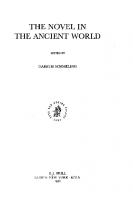House of the Waterlily: A Novel of the Ancient Maya World 9781785335501
Set in the Maya civilization’s Late Classic Period House of the Waterlily is a historical novel centered on Lady Winik,
235 21 678KB
English Pages 262 Year 2017
Contents
Preface
Chapter 1
Chapter 2
Chapter 3
Chapter 4
Chapter 5
Chapter 6
Chapter 7
Chapter 8
Chapter 9
Chapter 10
Chapter 11
Chapter 12
Afterword
Additional Resources
Discussion Guide
Acknowledgments
Recommend Papers

- Author / Uploaded
- Kelli Carmean
File loading please wait...
Citation preview
House of the Waterlily
House of the Waterlily A Novel of the Ancient Maya World
Kelli Carmean
berghahn NEW YORK • OXFORD www.berghahnbooks.com
Published in 2017 by Berghahn Books www.berghahnbooks.com
© 2017 Kelli Carmean
All rights reserved. Except for the quotation of short passages for the purposes of criticism and review, no part of this book may be reproduced in any form or by any means, electronic or mechanical, including photocopying, recording, or any information storage and retrieval system now known or to be invented, without written permission of the publisher.
Library of Congress Cataloging-in-Publication Data Names: Carmean, Kelli, 1960- author. Title: House of the Waterlily : a novel of the ancient Maya world / Kelli Carmean. Description: First edition. | New York : Berghahn Books, 2017. Identifiers: LCCN 2017030158 (print) | LCCN 2017030563 (ebook) | ISBN 9781785335501 (ebook) | ISBN 9781785335488 (hardcover : alk. paper) | ISBN 9781785335495 (softcover : alk. paper) Subjects: LCSH: Mayas--Social life and customs--Fiction. | Mayas--Civilization--Fiction. | Mayas--History--Fiction. | Mayas--Fiction. | GSAFD: Historical fiction. Classification: LCC PS3603.A75376 (ebook) | LCC PS3603.A75376 H68 2017 (print) | DDC 813/.6--dc23 LC record available at https://lccn.loc.gov/2017030158
British Library Cataloguing in Publication Data A catalogue record for this book is available from the British Library
ISBN 978-1-78533-548-8 hardback ISBN 978-1-78533-549-5 paperback ISBN 978-1-78533-550-1 ebook
Dedication For the Maya, past and present.
Contents
Preface
vii
Chapter 1
1
Chapter 2
21
Chapter 3
53
Chapter 4
73
Chapter 5
93
Chapter 6
120
Chapter 7
137
Chapter 8
159
Chapter 9
178
Chapter 10
197
Chapter 11
216
Chapter 12
223
Afterword
238
Additional Resources
243
Discussion Guide
245
Acknowledgments
249
Preface
Isn’t it a shame we can’t converse with the ancients? If we could, I believe we would find that we got many things mostly right about their societies, economies, political organizations, and perhaps even their religious worldviews. Yet it seems that we would also discover an important aspect of the study of ancient worlds that has mostly gone missing: the people themselves. Archaeology is not a discipline that easily engages at the scale of the individual; rather, it is most powerful at the community or the societal scale. Creative writing, however, is well suited to representations at the individual scale that, I believe, contribute to a greater understanding of the whole. The genesis of what became House of the Waterlily was sparked by a student at Eastern Kentucky University, where I teach. After I had regaled my young students with an undoubtedly rousing lecture on the Maya collapse, presenting detailed evidence of its many and varied interacting and contributing factors, a student asked, “But … what actually happened?” At first I was puzzled. Had he not been listening to what I said? Then I understood: while I was lecturing on the academic causality of the Maya collapse, he had been looking for its human story. At the time I muttered something like “Oh, it must have been terrible … full of chaos and death!” But once I started thinking about what actually happened at the human level, I couldn’t stop. My challenge then became how best to render my academic knowledge into an accessible written form offering a sound fictional portrayal of a vitally important and tragic lived human experience. House of the Waterlily is the result.
x
Impetus for writing House of the Waterlily also came from Mel Gibson’s problematic Hollywood movie Apocalypto. Although Gibson, a talented filmmaker, depicted visual elements of the Maya civilization quite well, there was much more that he got wrong. A quick example: time and space and culture in Apocalypto are so grossly conflated that we see the Spanish arriving at the height of the Classic period, and the Maya conducting Aztec-scale human sacrifices. Why are these mistakes important? My view is that Gibson deliberately manipulated the evidence with the goal of encouraging viewers to breathe a sigh of relief as Christianity lands on the shores to put the morally bankrupt Maya out of their misery. The problem is that much of the general public who watched Apocalypto likely learned everything they think they know about the Maya from it. I offer House of the Waterlily, humble though it may be in comparison, as a publicly accessible alternative to Apocalypto. House of the Waterlily is a work of historical fiction. It deliberately does not chronicle one person or family dynasty at one place or one time. Rather, it is an amalgam of archaeological and hieroglyphic material, or has been extrapolated from that material in, I hope, appropriate and probable ways. It takes place in what today is lowland Guatemala. House of the Waterlily is fiction, so people and places bear invented names. Centered on the fictional city of Calumook, the story is set at the very end of the Classic Maya Period, in the years around AD 830. Specialist Mayanist readers will recognize the general outline of events occurring toward the end of the occupation of Dos Pilas, but beyond that, Waterlily is a deliberate amalgam of Maya life and culture. In the Afterword, I offer some background to help readers place the story in its larger historical, anthropological, and Maya context. Many of the Maya gods I mention here cannot be proven to have existed in the Classic Period. Rather, they are a mix of historic Yucatec and other, modern interpretations of Classic Period gods. I aimed to animate the Maya cosmos as fully and richly as possible, because the sense of such a cosmos is what is accurate, regardless of time period. Throughout Waterlily, I offer a view of what Maya life could have been like around AD 830—not what it was like. To bring a sense of the Maya world and yet retain readability, I have used Maya and other indigenous terms sparingly. I have
also used Spanish in instances where it has been widely adopted by Maya speakers. I hasten to underscore, however, that the Classic Period ended some 700 years before the Spanish Conquest.









